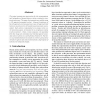Free Online Productivity Tools
i2Speak
i2Symbol
i2OCR
iTex2Img
iWeb2Print
iWeb2Shot
i2Type
iPdf2Split
iPdf2Merge
i2Bopomofo
i2Arabic
i2Style
i2Image
i2PDF
iLatex2Rtf
Sci2ools
119
Voted
CVPR
2003
IEEE
2003
IEEE
View Invariants for Human Action Recognition
This paper presents two approaches for the representation and recognition of human action in video, aiming for viewpoint invariance. The paper first presents new results using a 2D approach presented earlier. Inherent limitations of the 2D approach are discussed and a new 3D approach that builds on recent work on 3D model-based invariants, is presented. Each action is represented as a unique curve in a 3D invariance-space, surrounded by an acceptance volume (`action-volume'). Given a video sequence, 2D quantities from the image are calculated and matched against candidate action volumes in a probabilistic framework. The theory is presented followed by results on arbitrary projections of motion-capture data which demonstrate a high degree of tolerance to viewpoint change.
2D Approach | Candidate Action Volumes | Computer Vision | CVPR 2003 | Human Action | Model-based Invariants | Viewpoint Invariance |
Related Content
| Added | 12 Oct 2009 |
| Updated | 12 Oct 2009 |
| Type | Conference |
| Year | 2003 |
| Where | CVPR |
| Authors | Vasu Parameswaran, Rama Chellappa |
Comments (0)

